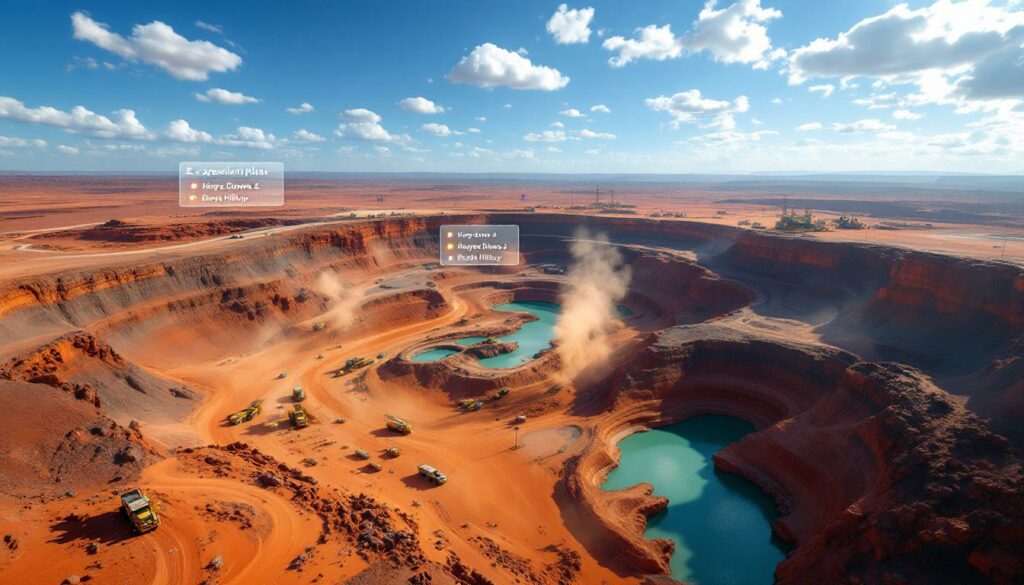What is the Hope Downs 2 Iron Ore Project and Why Does It Matter?
The Hope Downs 2 iron ore project represents a pivotal development in Australia's resource sector, with Rio Tinto and Hancock Prospecting committing to a substantial joint venture expansion in Western Australia's mineral-rich Pilbara region. This project builds upon the successful partnership established through the original Hope Downs operation, extending the productive life of one of Australia's most strategically important mining complexes.
Located in the heart of the Pilbara—a region responsible for approximately 90% of Australia's iron ore production—Hope Downs 2 will develop two significant deposits with direct integration into existing infrastructure. The project's importance extends beyond its immediate economic impact, reinforcing Australia's dominant position in global iron ore price trends and markets, where the country currently accounts for 54% of global seaborne iron ore exports.
The development arrives at a critical juncture for Australia's resources sector, with iron ore exports valued at A$136 billion in 2023-24, making it the nation's most valuable export commodity. By maintaining production capacity and leveraging the region's naturally high-grade ore (averaging 62% Fe content compared to the global average of 48%), Hope Downs 2 helps secure Australia's competitive advantage in supplying premium iron ore to global steel producers.
Strategic Significance for Western Australia
Beyond the immediate production benefits, Hope Downs 2 represents a vote of confidence in Western Australia's mining industry evolution, which employs over 130,000 people and contributes approximately 40% of the state's royalty revenue. The project's approval signals long-term faith in both the region's geological advantages and regulatory framework, which has successfully supported resource development for decades.
How Much Are Rio Tinto and Hancock Investing in Hope Downs 2?
Investment Details and Project Scope
Rio Tinto and Hancock Prospecting are jointly investing A$2.4 billion (US$1.6 billion) to develop the Hope Downs 2 project, continuing their 50/50 partnership model that has proven successful with previous operations. This substantial commitment will fund the development of two key deposits—Hope Downs 2 and Bedded Hilltop—with a combined production target of 31 million tonnes per annum (Mtpa) of high-quality iron ore.
The investment comes with all necessary state and federal government approvals already secured, allowing for immediate commencement of development activities. First ore production is targeted for 2027 following approximately two years of construction and commissioning work, with progressive ramp-up to full capacity thereafter.
This capital commitment is comparable to Rio Tinto's recent Western Range project (A$2.7 billion) but represents a more efficient investment when measured against production capacity, largely due to the integration with existing Hope Downs 1 processing facilities.
Economic Impact and Employment Generation
The project will create more than 950 jobs during the peak construction phase, providing significant employment opportunities in a region where mining jobs typically command premium wages. Once operational, Hope Downs 2 will help sustain approximately 1,000 full-time equivalent positions across the Greater Hope Downs operations.
These employment figures represent more than individual jobs—they translate to sustained economic activity throughout Western Australia's supply chains. Local businesses from equipment suppliers to service contractors will benefit from the project's development, while the ongoing operations will continue generating tax and royalty revenues for decades.
For context, iron ore royalties contribute approximately 40% of Western Australia's total mining royalties, making projects like Hope Downs 2 critical to the state's fiscal health and public service delivery capacity.
What Makes the Hope Downs 2 Project Strategically Important?
Securing Future Production Capacity
Hope Downs 2 plays a crucial role in sustaining production from the existing Hope Downs joint venture, effectively extending the operational lifespan of this significant asset. By developing these new deposits and integrating them with the Hope Downs 1 processing facilities, Rio Tinto and Hancock Prospecting have crafted a capital-efficient approach to maintaining production levels.
The project forms an integral part of Rio Tinto's broader strategy to not merely maintain but enhance its Pilbara operations, supporting the company's goal to increase annual capacity from 345Mtpa to an ambitious 360Mtpa. This capacity expansion comes at a time when high-grade iron ore remains in strong demand for steel production, particularly as global steelmakers face increasing pressure to reduce carbon emissions.
Industry analysts note that the Pilbara's higher-grade ore (typically 62% Fe content) produces less emissions during steel manufacturing compared to lower-grade alternatives, positioning Australian producers favorably in an increasingly carbon-conscious global market.
Alignment with Long-Term Market Fundamentals
The significant capital commitment demonstrates continued confidence in iron ore demand insights despite short-term price volatility. This investment perspective aligns with projections from the World Steel Association that forecast global steel demand reaching approximately 1.8 billion tonnes by 2030, requiring sustained high-quality iron ore supply.
By maintaining its production capacity through strategic replacement projects like Hope Downs 2, Rio Tinto preserves Australia's critical role in global steel supply chains that underpin infrastructure development across Asia and beyond. The company's willingness to commit substantial capital during variable market conditions signals a long-term perspective that looks beyond cyclical price movements.
How Does Hope Downs 2 Fit into Rio Tinto's Broader Investment Strategy?
Part of a Comprehensive Mine Replacement Program
Hope Downs 2 represents one component of Rio Tinto's systematic approach to maintaining Pilbara production through strategic mine replacements. Alongside other key projects including Western Range, Brockman Syncline 1, West Angelas, and Greater Nammuldi, these developments will provide approximately 130Mtpa of replacement capacity—essential as older mines reach the end of their productive lives.
This replacement strategy forms part of Rio Tinto's projected US$13 billion investment in new mines, plant, and equipment by 2027, highlighting the company's continued commitment to its Australian operations despite opportunities in other global mining jurisdictions. The approach represents a carefully sequenced pipeline of developments designed to maintain production consistency while optimizing capital allocation.
Western Range, which achieved first ore in 2024, provides a recent example of Rio Tinto's successful execution of this replacement strategy. These sequential project developments help the company maintain consistent production while spreading capital requirements across multiple budget cycles.
Complementary to Future Strategic Developments
Hope Downs 2 also works in concert with Rio Tinto's longer-term development plans, particularly the substantial Rhodes Ridge project currently in pre-feasibility studies. Rhodes Ridge represents one of the world's largest undeveloped iron ore deposits and is targeting an initial capacity of up to 40Mtpa with first ore expected by 2030.
Together, these projects create a pipeline of production capacity extending decades into the future, securing Rio Tinto's position as a leading global iron ore producer. The company's willingness to invest approximately $40 billion in its Pilbara operations since 2010 demonstrates extraordinary confidence in both the resource base and Australia's position as a preferred mining jurisdiction.
"These investments aren't just about maintaining production—they're about securing Australia's position in global supply chains for decades to come. In a world of increasing geopolitical uncertainty, stable resource suppliers become increasingly valuable." — Mining industry analyst perspective
What Are the Operational Details of the Hope Downs 2 Project?
Mining and Processing Approach
Hope Downs 2 will extract ore from two distinct deposits—Hope Downs 2 and Bedded Hilltop—using conventional open-pit mining methods typical of Pilbara iron ore operations. The extracted ore will be transported approximately 50 kilometers to the existing Hope Downs 1 processing facilities, leveraging infrastructure already in place rather than requiring entirely new processing capacity.
This integration with existing facilities represents a significant capital efficiency, allowing the joint venture partners to minimize upfront investment while maximizing returns. The approach also reduces the project's environmental footprint by utilizing established processing, power, and water infrastructure rather than duplicating these assets.
Like many modern Pilbara operations, Hope Downs 2 will likely incorporate autonomous haulage systems and other advanced technologies to enhance safety and operational efficiency. Rio Tinto has been at the forefront of mining automation, with its Koodaideri operation (now Gudai-Darri) serving as a blueprint for intelligent mining techniques that may be applied at Hope Downs 2.
Timeline and Production Targets
Development activities are commencing immediately following project approval, with the construction phase expected to span approximately two years. This timeline aligns with similar replacement projects in the Pilbara, where Rio Tinto has established efficient project delivery protocols.
First ore is expected in 2027, with production ramping up progressively to reach the full capacity of 31Mtpa. This gradual approach allows for operational optimization and ensures smooth integration with existing production systems.
The project will utilize Rio Tinto's established rail and port infrastructure in the Pilbara, connecting to the company's extensive network that transports ore to shipping facilities at Dampier and Cape Lambert. This integrated logistics system represents one of Rio Tinto's key competitive advantages in the region.
What Does This Investment Signal About Australia's Iron Ore Industry?
Continued Confidence in Long-Term Market Fundamentals
The $2.4 billion commitment to Hope Downs 2 signals robust confidence in the long-term fundamentals of the iron ore price forecast, despite the cyclical nature of commodity prices. This investment joins approximately $22 billion in committed capital across Western Australia's iron ore projects, demonstrating industry-wide belief in sustained demand.
Australia's competitive advantage in iron ore production remains compelling, with average cash costs of approximately $30 per tonne compared to Brazil's $40 per tonne (according to Wood Mackenzie analysis). This cost advantage, combined with proximity to Asian markets and political stability, continues to position Australian producers favorably against global competitors.
The development also aligns with the evolving requirements of global steelmakers pursuing decarbonization strategies. According to the International Energy Agency's Iron & Steel Technology Roadmap, high-grade Pilbara ore remains critical for reducing emissions in steel production, creating potential price premiums for Australian producers as carbon constraints tighten globally.
Reinforcing Australia's Position in Global Supply Chains
Hope Downs 2 helps cement Australia's role as the world's leading iron ore exporter, currently supplying 54% of global seaborne trade. This dominant market position translates into significant economic benefits, with iron ore contributing approximately $136 billion in export value during 2023-24.
The project also demonstrates confidence in Australia's regulatory framework and resource governance, particularly important as global miners increasingly factor political risk into investment decisions. The successful progression of Hope Downs 2 through approval processes highlights Western Australia's efficient resource development pathways.
"In an era when resource nationalism is rising globally, Australia's continued ability to attract major mining investments speaks to its enduring advantages as a mining jurisdiction—stable regulation, world-class geology, and established infrastructure." — Resources industry perspective
What Perspectives Do Industry Leaders Offer on the Project?
Executive Insights on Strategic Importance
Simon Trott, Rio Tinto's CEO Iron Ore, emphasized the project's significance, stating: "Approval of Hope Downs 2 is a key milestone for Rio Tinto, as we invest in the next generation of iron ore mines in the Pilbara."
Trott's commentary highlights Rio Tinto's confidence in sustaining Pilbara production for decades to come, reinforcing the region's critical contribution to global steel supply for over 60 years. His leadership perspective carries particular weight given his extensive experience in Rio Tinto's iron ore business.
While the announcement did not include direct commentary from Hancock Prospecting leadership, the 50/50 joint venture structure continues a successful partnership model that has delivered significant value to both organizations. Hancock Prospecting, led by Executive Chairman Gina Rinehart, maintains a strategic position in Australia's iron ore sector through this and other key mining consolidation strategies.
FAQ: Hope Downs 2 Iron Ore Project
When will the Hope Downs 2 project begin producing iron ore?
The project is targeting first ore production in 2027, following approximately two years of development and construction work. Full production capacity of 31Mtpa will be achieved progressively after initial production commences.
How does Hope Downs 2 compare to other iron ore developments in the region?
Hope Downs 2 (31Mtpa) is comparable in scale to other replacement projects in Rio Tinto's pipeline but smaller than the planned Rhodes Ridge development (up to 40Mtpa). It forms part of a broader replacement mine strategy with a combined capacity of 130Mtpa across several projects.
What is the relationship between Hope Downs 1 and Hope Downs 2?
Hope Downs 2 will utilize the processing facilities at Hope Downs 1, creating operational synergies and optimizing capital efficiency. This integration extends the productive life of the joint venture while leveraging existing infrastructure investments.
How does this investment reflect on the current state of the iron ore market?
The substantial $2.4 billion commitment indicates confidence in the long-term fundamentals of the iron ore market despite short-term price fluctuations. Rio Tinto and Hancock Prospecting are positioning for sustained demand driven by ongoing urbanization and infrastructure development, particularly in Asian economies.
What environmental considerations apply to the Hope Downs 2 development?
Like all major resource projects in Western Australia, Hope Downs 2 has secured approvals under both state environmental legislation and the federal Environment Protection and Biodiversity Conservation Act. The project will implement water management systems typical of Pilbara operations, including dewatering approaches to manage groundwater interactions.
Disclaimer: This article contains forward-looking statements regarding production targets, timelines, and market conditions. Actual outcomes may vary based on operational developments, market conditions, regulatory changes, and other factors outside the control of the project partners.
Wondering How to Capitalise on Major Mineral Discoveries Like Hope Downs 2?
Discovery Alert's proprietary Discovery IQ model instantly identifies significant ASX mineral announcements, giving you an edge in the market before others recognise their potential. Explore how past discoveries have delivered exceptional returns by visiting the Discovery Alert discoveries page and position yourself for the next major opportunity.




